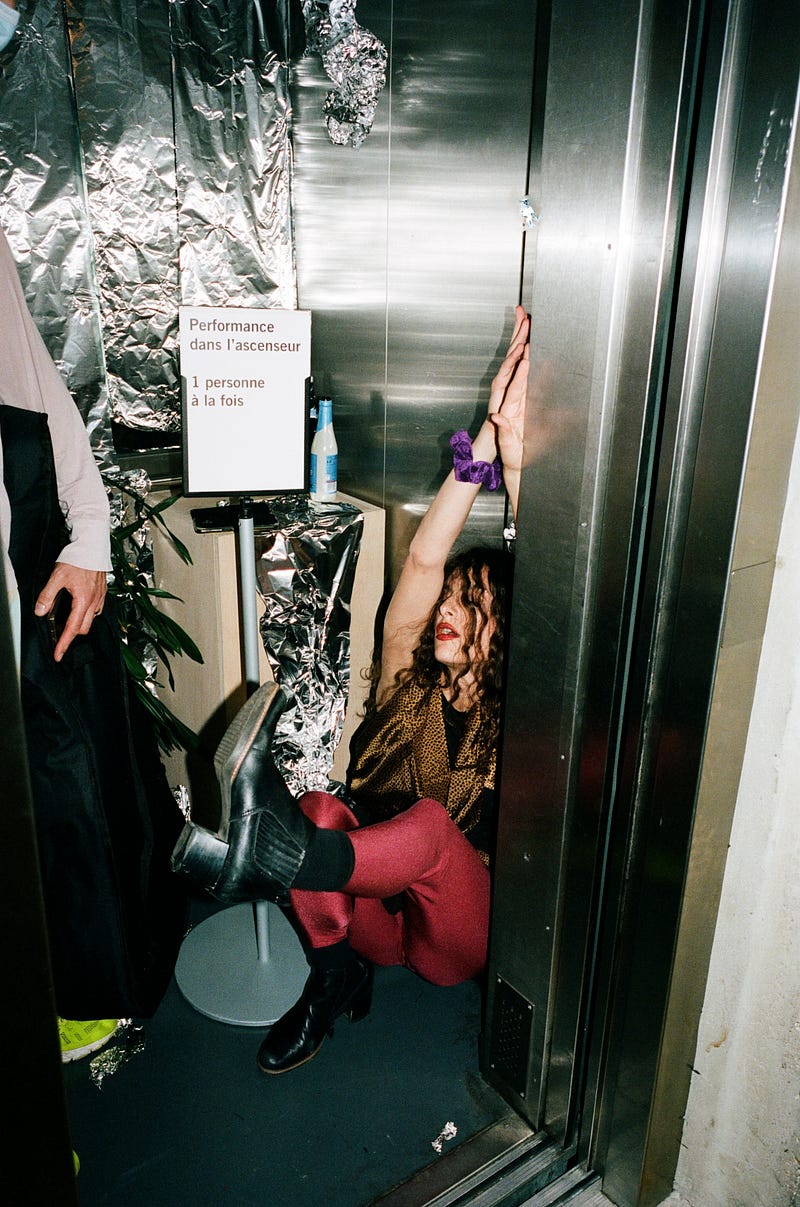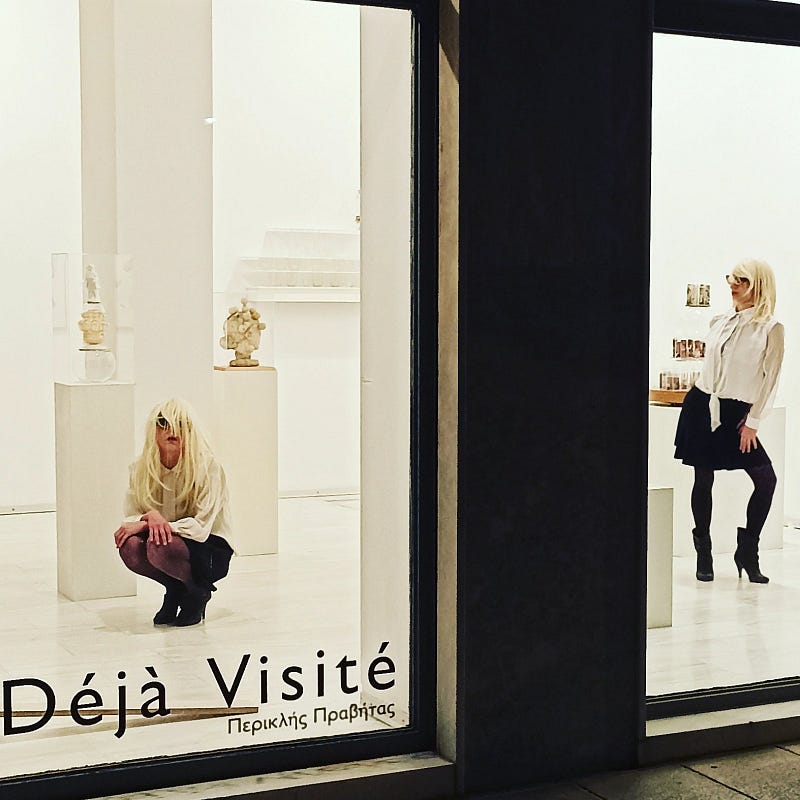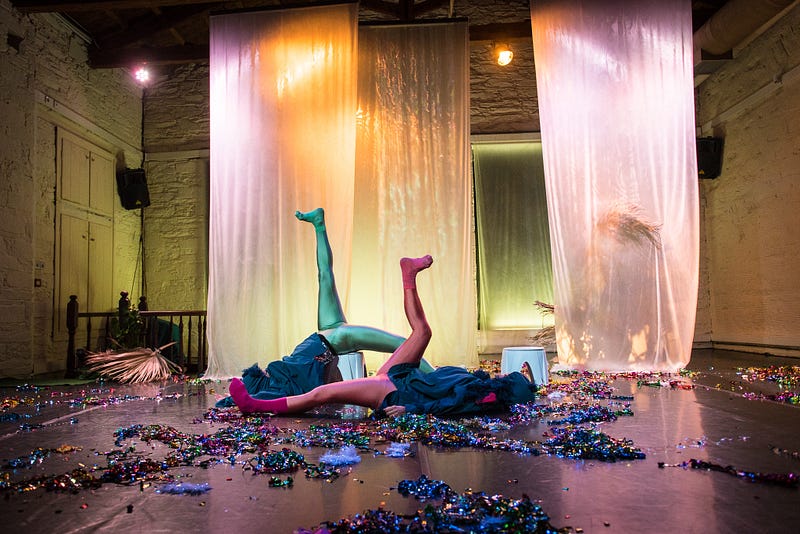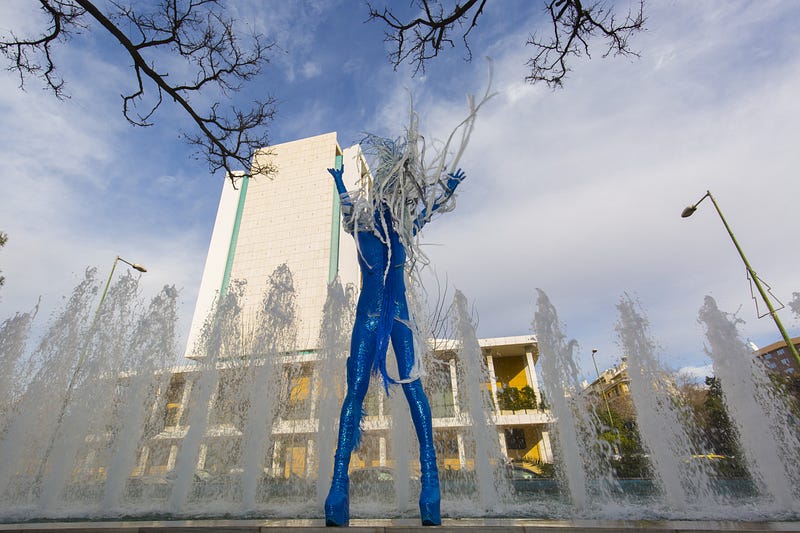15.11.2023
Have we met before? You look strangely familiar.
Dance
When I think of Natasha Sarantopoulou’s performances, the first thing that comes to mind is ambiguity. An ambiguity, however, that has little to do with vagueness or inexactness; in her case―and often of her co-performer, Ioanna Antonarou―is an act of baffling intimacy. But again, this type of intimacy isn’t merely about closeness or proximity. Actually, it feels more like a space of unclassified in-betweenness, where one can fruitfully negotiate identity, movement, embodiment and ultimately choreography. This might be the space of an ‘inoperative’ choreography, of a different economy of the body, of a riddled gaze that is confronted with pre-existing notions of dance performance. Though it might be difficult to classify it, Sarantopoulou’s work often feels like entering a certain (un)familiar zone or atmosphere―I deliberately avoided saying ‘dreamy’ just to keep in mind this unsettled idea of ‘baffling intimacy.’

Indeed, the so-called zone/atmosphere in Sarantopoulou’s performances is more than just about scenery, props or costumes, even though all are constituent parts of her world; be it a gallery, an elevator or a submerged river, space in her work remains laden with something pre-existing, evocative of ‘other’ times, places, beings. It is maybe for this reason that her movement vocabulary proposes a state in which bodies are ‘trapped,’ at times incoherent or in a sort of movement-stuttering―what we above referred to as ‘inoperative,’ because progression doesn’t imply the completion of an action, a climax or a transition, but rather an ‘exhaustion,’ just like André Lepecki suggested in his much-cited work Exhausting Dance¹. In that sense, exhaustion surpasses the act of saturation, goes beyond tiredness and repetition to become an opportunity of examining anew the limits of any given convention. If dance regularly implies a movement-in-flow and, thus, a dancer in total control of her movements, which then underlines the interrelation of dancing as purposeful moving, here dancing is adjacent to failure and to the lack of command, which otherwise is so often exhibited in the discipline of choreography. However, exhaustion isn’t pure negation of choreography or the performative within, but instead a way to reassess the limits of choreography and the bodies captured in it.

What kind of bodies do we see anyway? In Jamais Vu² they look like a couple of identical preppy school girls, wondering in the space of a gallery, examining the artefacts from Periklis Pravitas’ exhibition, “Déjà visité.” Anyone could be beguiled by their seemingly mainstream look, the two performers would even pass unnoticed if it hadn’t been for their sloppy, uncontrollable limbs and their exaggerated manner, a bit childish at a first glance, a bit frustrating too―you can’t really tell if they are under some spell or if they have been out partying for the last two days. But maybe it is exactly this ‘undecidability’ that characterizes Sarantopoulou’s work; in It’s better in the Bahamas³ we are introduced into an afterparty ‘zone’―or so it seems― a space once marked by a festive occasion, but still not exactly, since whatever it has taken place there it is now over. The two performers linger over the traces of something that was there, wearing their raincoats and glistening leggings to match the colors of the streamers, scattered now all over the stage. The movement is once again sloppy, hands flickering, feet turned inwards, thighs in a V shape, legs unable to support the torso, hunchbacked but still astonishingly agile. There is endurance and errancy, a paradoxical pairing of qualities one might say, nevertheless an engaging one, if we think of the concept of ‘exhaustion’ and the proposed disruption within the artform of dancing.

As stated above, ‘exhaustion’ disrupts knowledge in order to invent knowledge. But what does this mean in terms of movement vocabulary and in relation to Sarantopoulou’s work? To answer this question, I would like to propose the concept of the ‘unruly body’―not so much as an accomplished and finite methodology to produce movement, but as a tool to sustain its continued re-examination and to cherish what (sometimes stubbornly) resists knowledge. Moreover, I say unruly to imply a type of dis-orientation that one experiences often in her performances, an invitation to follow her on a trip but without destination, to resist, thus, the very demand of a show, which is exactly to ‘show:’ to exhibit, to make evident, to point at a certain direction. There is no better example than the digital performance ILISSOS / limbo eξótica⁴ which strongly reminded me of Anna Halprin’s Still Dance ―a creative process of “weaving together performance, body art, story, photography and the particularity of a place”⁵ to put it in her exact words. Halprin investigated the impetus of the danced exploration as a form of dialogue between performer and place, rather than a conventional performance that it is often this ‘still point’ documented in pictures. As in Halprin’s captivating images, Sarantopoulou alters the way in which we see herself in relation to the natural/urban surrounds; the digital 3D installation is placed ‘underground’ just like the current of the submerged river Ilissos, emphasizing the sense of entrapment in a dungeon-like environment made of cement. The atmosphere is in sheer contrast with the vivid images, depicting her lean, tall physique in a blue, full-face costume, her figure already in contrast with the surrounding reality―that of the Athenian city-life during the pandemic but also of the many invisible layers of history, still present, unfolding in a parallel universe.

I mentioned in the beginning of this text a quality in Sarantopoulou’s work I named ‘baffling intimacy.’ I said baffling because I see in her and her work something that goes beyond the immediacy of ‘movement-exhibition,’ a distortion of the much-worshipped kinaesthesia but also a distortion which nonetheless has a lot to say about intimacy. To consider intimacy within familiarity is to reduce contact with our strangeness or otherness. It is within this logic that I chose the title, “Have we met before? You look strangely familiar,” implying maybe, a lived or imagined experience, an embodied knowledge which is both affirmed and questioned upon meeting the other.
Natasha Sarantopoulou graduated from the Greek National School of Dance in Athens (KSOT 2009–2012). As a performer, she has collaborated with a number of directors and choreographers (Kostas Fillipoglou, Apostolia Papadamaki, Nikos Mastorakis, Sofia Spyratou, Chet Walker, Default Company, Themis Moumoulidis, Dimitris Mylonas and Stathis Athanasiou), performing in various theaters and events across Greece (Athens and Epidaurus Festival, National Opera of Greece, Sani Festival and Badminton theatre, among others). As a movement director, she has worked in theatrical performances presented in venues such as the National Theater of Greece, Municipal Theater of Piraeus, Neos Kosmos Theater, etc. Together with Ioanna Antonarou, they created their choreographic pieces Walk Lola Walk and It’ s Better in the Bahamas. The staging of the latter piece was funded by the Greek Ministry of Culture. She has been awarded the Stavros Niarchos Foundation Artist Fellowship by ARTWORKS in 2020.
Anastasio Koukoutas is working in the field of dance theory, dramaturgy and writing. He studied (BA) Communication and Marketing at the Athens University of Economics, (MA) Performing Arts Administration at Accademia Teatro alla Scala (in collaboration with Bocconi University), Ethnomusicology at the National and Kapodistrian University of Athens (within the e-learning course Greek Music Culture and Education). He has worked, in the publishing field, as a contributor and editor, for art institutions and organizations, such as: Athens & Epidaurus Festival, Stegi Onassis, Dimitria Thessaloniki Festival, Megaron — The Athens Concert Hall et.al. He has worked as a dramaturg in theatre and dance performances (Athens Festival, Stegi Onassis, Experimental Stage of National Theatre in Greece, Arc for Dance Festival, Porta Theatre — Athens et.al.). He writes frequently about dance for the websites springbackmagazine.com, artivist.gr, und-athens.com, and teaches Dance History at the dance college ΑΚΤΙΝΑ. Last but not least, he has worked as a performer for Denis Savary (Lagune –National Museum of Contemporary Art, Athens — 2016), Virgilio Sieni (Biennale Danza / La Biennale di Venezia — 2016), Pierre Bal Blanc (documenta14–2017), Dora Garcia (Megaron, The Athens Concert Hall — 2018) et. al.
¹ André Lepecki, Exhausitng Dance; Performance and the politics of movement, Routledge, New York and London, 2007.
²Jamais Vu was a pop-up performance by Natasa Sarantopoulou and Ioanna Antonarou in the context of the exhibition “Déjà visité” by the artist Periklis Pravitas at the Gallery Ekfrasi — Gianna Grammatopoulou. It premiered in October 22nd 2021 and it was supported by NEON Organization.
³ The dance performance It is better in the Bahamas premiered in the context of the ARC for Dance Festival (11th edition).
⁴“ILISSOS / limbo eξótica” was presented in the form of a digital installation during the Onassis New Choreographers Festival (8). By means of a pre-recorded 360-degree video journey on YouTube, visitors had the opportunity to wander around a three-dimensional depiction of the installation which consisted of photographs and videos depicting the course of the River Ilissos through modern-day Athens.
⁵ Libby Worth & Helen Poynor, Anna Halprin, Routledge, New York and London, 2004.



